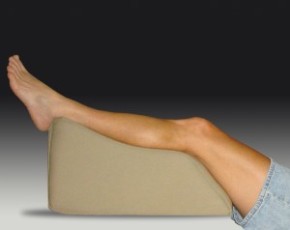Soccer is a sport that places a high demand on the musculoskeletal system. Soreness and eventual injury to muscles, joints, tendons and ligaments are all inevitable consequences of playing the sport. The “R.I.C.E.” method – an acronym which reads “Rest, Ice, Compression, Elevation” – is an efficient and effective means of dealing with soreness and injury. In my work as a soccer fitness coach, I have recommended this protocol to several hundred athletes. Of the four letters, I have found that it is typically the “E” – “Elevation” that confuses athletes the most. Exactly what is elevation? And why is it so important for optimal recovery from soreness and injury?
Elevation refers to the act of elevating the legs above the heart. This is best accomplished by lying on a couch or bed that is located near a wall. Straighten the legs and place the feet on the wall, with the heels of the feet in contact with the wall. The knees should be slightly bent but relatively straight. Keep the legs elevated for 20-30 minutes, keeping the head and upper body in a relaxed and comfortable position.
The rationale for elevating the legs above the heart is that it will promote venous return. In the hours (and days) after strenuous exercise, de-oxygenated blood can remain pooled in the lower extremities. This can increase inflammation and thus prolong muscle soreness and pain/swelling from muscle, tendon, or ligament injuries. It is the venous system – veins – that are responsible for carrying de-oxygenated blood back to the heart, where it is then transported into the lungs to receive oxygen taken in from the air. The problem with this system is that, when the body is held upright (and to a lesser extent, when it is held in a horizontal position) the veins must constantly work against gravity to move the blood upwards (or sideways) to get it back to the heart. Elevating the legs above the heart allows the forces of gravity to work with the venous system, rather than against it. Blood is much more easily transported downwards to the heart where it can receive the oxygen it needs, and at the same time remove inflammatory byproducts of exercise that cause pain and soreness.
The R.I.C.E. protocol is a useful tool for any soccer player, regardless of age or level of ability. Elevation of the lower extremities as described above, is particularly effective both to recover from injuries, as well as in the preemptive prevention of over-use injuries that can be caused by increased inflammation and blood pooling in the legs following training and games. We used a protocol of 20-30 minutes of lower limb elevation following every training session and game when I worked with the Canadian National Women’s U17’s in 2011/2012, and with the Toronto FC Academy teams in 2013, and it worked very well for us in both instances. Try this Elevation strategy out after your next training session or game to see the results for yourself. Good luck!
I’d love to hear your thoughts about this topic. Drop me a line here to get the conversation started.


Leave A Comment